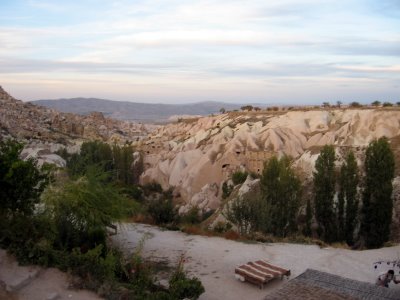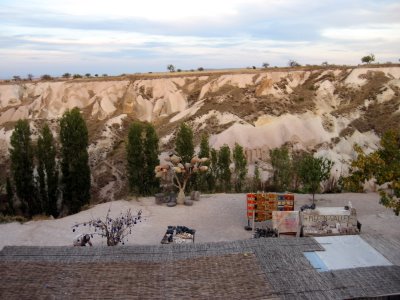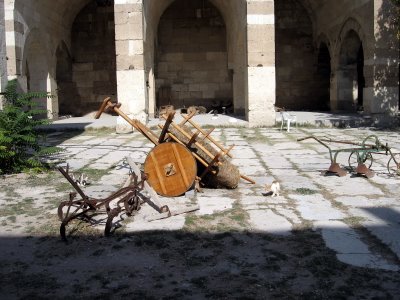Our last day of our round trip through Turkey, we spent in Myra the town of St. Nicholas. The one who today is known as Santa Claus or even Father Christmas. I didn't know that he lived in Turkey ! And his story is not very romantic either.
Saint Nicholas also called Nikolaos of Myra, was a historic 4th-century saint and Greek Bishop of Myra (Demre, part of modern-day Turkey) in Lycia, born on 6 December 270 – 343 He was the only son of wealthy Christian parents. His parents died in an epidemic while Nicholas was still young and he was raised by his uncle—also named Nicholas—who was the bishop of Patara.
Saint Nicholas church fell into ruins after his death and only in 1863 Czar Alexander II of Russia bought the building and started to have it restored, but the work was never finished. The floor of the church is made in mosaic of coloured marble, very beautiful and there are also some remains of wall-paintings. A Greek marble sarcophagus had been made to bury the Saint, but his bones were stolen in 1087 by merchants from Bari (Italy), and now held in the cathedral of that city. The sarcophagus in Myra is empty. The Bari merchants only collected just half of Nicholas' skeleton, leaving all the minor fragments in the grave. These were collected by Venetian sailors during the first crusade and brought to Venice, where a church to St. Nicholas, the patron of sailors, was built on the Lido. This tradition was confirmed in two scientific investigations of the relics in Bari and Venice, which revealed that the relics in the two cities belong to the same skeleton.
----------------------------------------------------------------
The real St. Claus
and what is left of his church !

-------------------------------------------------------------------------------------
Entrance of the church

-------------------------------------------------------------------------------------
Beautiful mosaic

-------------------------------------------------------------------------------------------
The sarcophagus of St. Nicolaus
There are many orthodox christian pilgrims coming here and we saw a whole group praying in front of the sarcophagus

another quiet well preserved corner

the rest of the church is in a rather sad state !
at least two souls watching over St.Claus, they live in the church.

outside the church a statue of Saint Nicholas

and the "new" Santa Claus turning his back to the church.
You can read the whole story of Saint Nicholas here
Sunday, October 01, 2006
MYRA (Turkey) THE TOWN OF ST. NICHOLAS
Posted by Ingrid at Sunday, October 01, 2006 0 comments
travel, vacation, Jordan, Egypt, Spain, Turkey, Myra, Saint Nicholas, Santa Claus, Turkey
TURKEY - THE CARAVAN ROAD
In May I made a round trip through Turkey. I choose the Caravan Road which leads through the most beautiful landscapes of Turkey.
I took the airplane from Brussels to Antalya and the next day early morning (we had to leave the hotel everyday between 6 and 7am) we made our first part of the trip to Fethiye (about 195 km/121 miles) stopped and visited Hierapolis.
(I dont want to give history lessons here if you wish to learn more about this site
please look here.)
We drove through the marvolous Taurus mountains and suddenly arrived in Hierapolis.
This ancient town was built by the greeks and continued by the romans. Wealthy people stayed there to bath in the springs of Pamukkale.
There are still escarvations going on, because there are still ruins to be discovered.
An arena, very well conserved with seats for 30.000 people !
----------------------------------------------------------
and hehere the Lions were kept
The "house of parliament" where already at that time politicians promised heaven on earth (I suppose)
__________________________________________________________________
parts of sarcophagus stones
The sarcophaguses were sculptured masterpieces
When we finished our visit, we drove over to Pamukkale/Cappadocia explanation here . I saw this beautiful place, and remained speachless (which doesn't happen very often) It is so undescribably when you see it that it's better I don't describe it either. It looked like a snow landscape, but it was all out of chalk. People were allowed to walk barefoot in the blue, salty water which was very warm. For this place Greeks and Romans had built Hierapolis to profit from the mineral springs.
---------------------------------------------------------
------------------------------------------------------
The next day we did the longest way of our roundtrip almost 800 km (497 miles) But as the landscapes were so interesting and our group so funny, time went by very quickly. We also stopped every two hours and could walk and drink something. In my whole life I haven't seen so many fields of sugar beets, km and km long. A lot of trucks were on the road too, loaded till overloaded with sugar beets. On both sides of the very nice road goats and cows were browsing and sometimes our driver had to slow down. No soul around except some farmers on the fields. We were on the Caravan road, where camels loaded with silk, weapons, spices and jade came from China.
Then we arrived in the mountains again and stopped in central Anatolia to look at the clay houses built against the rocks. Until 1960 people lived in the rocks in which rooms were carved. As it was not safe anymore, the government decided to move people out, but they were allowed to build their houses as an annexe to the rock house where they used to live. So sometimes you see a house really glued to the entrance where now the rooms are used as food storage. Decorated with TV antennas it really looks special.
--------------------------------------------------------
Here we were welcomed by the turkish youth and a lady who wanted to sell us scarfs
(look at the houses nested against the rocks)
_____________________________________________________________
Some front doors ...
------------------------------------------------------------
View over the mountains
We also visited an onyx factory, where beautiful vases or other decorations were abraded. Here he showed us how he made an onyx egg. It looked so nice that I bought two for only 3 € a piece.
After that we visited a carpet factory. They made beautiful carpets and you can see two women weaving.
--------------------------------------------------------------
In another factory ceramic objects were made and as I had done some pottery and sculpturing in the past, they asked me to do something. I did it with fun, I made a cat !The guy and the others were very pleased and he told me that this had been the first time that a visitor had worked for him.
-------------------------------------------------------------------------
We spent two days in this moonland Carpadoccia, and I think it was one, if not the most beautiful place we all had ever seen.
-----------------------------------------------------------------
It is amazing what kind of sculptures mother nature can create
____________________________________________________________________________________
___________________________________________________________________________________
In some of the grottos orthodox christians hid from arab attacks around 600 AC. These grottos were so well carved that a whole village could live in there and the entrance so well hidden, that we would never had found it, if there had not been a sign and a guardian. They had everything. Dormitories, kitchens, rooms, and storage rooms for food. They built a such sophisticated aeration systhem, that it was impossible for the assaulters to put poison in it. The walks which related the rooms were so narrow and low that we had to crawl through with bent heads and one of us got stuck !
---------------------------------------------------------------------------------
There were even prayer rooms with surprisingly well preserved paintings
---------------------------------------------------------------
and of course modern times also arrived here, we watched a movie team who made a video clip with this singer, who apparently was very famous in Turkey. It must have been a very dramatical love story, as the woman's face was wet with tears.
---------------------------------------------------------------------------
------------------------------------------------------------------
----------------------------------------------------------------------
And then we saw this police station here and were invited to go in.
------------------------------------------------------------------------
Inside the police station
We returned to the Caravan road and arrived at the first Kervansaray. Of course men and camels had to rest and therefore every 40 km a Kervansaray had been built which allowed to stay there for some days. It was a kind of ancient Motels along the highway. There were bedrooms for men and animals, a surgery room for the vet and the doctor and also dining rooms, bathrooms and toilets (not recommended)
------------------------------------------------------------
going through, right and left the rooms
----------------------------------------------------------
some old tools laying around on the pavement of the interior place
------------------------------------------------------
We walked through the exit and ...
------------------------------------------------------------
were looking at this !
A beautiful lake 80 m (263 ft) deep. A wonderful turquoise color. The water is used for producing electricity. There are no fishes in and you can't swim in there.
After all these natural miracles, we arrived in Konya and visited the Mevlana museum. Here lived in the 13th century the Persian poet, jurist, and theologian Rumi who had a significant influence on Turkish literature throughout the centuries. His poems have been translated into many of the world's languages and have appeared in various formats.
After Rumi's death, his followers founded the Mevlevi Order, better known as the "Whirling Dervishes", who believe in performing their worship in the form of dance and music ceremony. Rumi is burried here and many pilgrims are coming to visit his sarcophagus.
______________________________________________________________
_______________________________________________________________________
The inside is very beautiful and many of his original writings are exposed here.We have been told by our guide, that many muslims are coming here because of very old handwritten Korans.
----------------------------------------------------------------------
Old couple admiring the Koran and kissed the display case.
-------------------------------------------------------
Coffins of Whirling Derviches.
------------------------------------------------------------------
and the coffin of their master Rumi
-------------------------------------------------------------
Whirling Derviches council in wax
---------------------------------------------
When Devishes danse they turn and turn around first slowly and more and more accelerated until they turn so quick that you can rather follow. They are then in a kind of trance.
From there we went over visiting the Mosque of Conya. We had to take our shoes off and cover our heads. Inside somebody read the Koran and after a while changed with another who continued. They had no special cloths on. On the floor men were praying and some children, boys and girls were chatting in a corner.
___________________________________________________
Mosque of Conya
------------------------------------------------------------------
The next day we drove along the anatolian lakes, which is not very well known by foreign tourists, but very much appreciated by the turkish tourists.
--------------------------------------------------
The little village with it's shepherd
We arrived in a small village where we had a very nice lunch in a local Restaurant.
-----------------------------------------------------------------
----------------------------------------------------------------------
The kitchen with Grandma and the son of the house, just coming back from school.
-----------------------------------------------------------------
Our fresh trout was prepared here. It was excellent !
Here a woman peels oignons. I didn't approach too much, I am always crying when I see an onion.
-------------------------------------------------------------------
After lunch we drove deep in the mountains direction Aglasun where we visited Sagalassos an archaeological site. In Roman Imperial times, the town was known as the 'first city of Pisidia', a region in the western Taurus mountains, currently known as the Lake District from which we came from. From 1990 Sagalassos has been, in addition to being a major tourist site, a major excavation project lead by Marc Waelkens of our Catholic University of Leuven in Belgium. One is now exposing the monumental city center; four major restoration projects there are (nearly) completed. It is absolutely amazing that people were able to build a whole town in the middle of such high mountains. (1.400m) and it surprises you so much when you drive through a mountain wilderness and suddenly discover such a site.
--------------------------------------------------------
It was built by the romans (of course)
---------------------------------------------------------------------
Our last day we spent in Myra the town of St. Nicholas. The one who today is known as Santa Claus or even Father Christmas. I didn't know that he lived in Turkey ! And his story is not very romantic either.What a deception for children. His church fell into ruins after his death but in 1863 Czar Alexander II of Russia bought the building and started to have it restored, but the work was never finished. The floor of the church is made in mosaic of coloured marble, very beautiful and there are also some remains of wall-paintings. A Greek marble sarcophagus had been made to bury the Saint, but his bones were stolen in 1087 by merchants from Bari (Italy), and now held in the cathedral of that city.
In 1863 Czar Alexander II of Russia bought the building and started to have it restored, but the work was never finished. The floor of the church is made in mosaic of coloured marble, very beautiful and there are also some remains of wall-paintings. A Greek marble sarcophagus had been made to bury the Saint, but his bones were stolen in 1087 by merchants from Bari (Italy), and now held in the cathedral of that city.
-------------------------------------------------------------
The real St. Claus
-----------------------------------------------
Entrance of the church
------------------------------------------------------------
The sarcophagus of St. Nicolaus
There are many orthodox christians pilgering to here and we saw a whole group praying in front of the sarcophagus
----------------------------------------------------------
Beautiful mosaic work
----------------------------------------------
and in the church two souls watching over St. Claus
-------------------------------------------------------------
After our visit to St. Claus we finished with a visit to Kekova.
It is a small island with a village which is partly sunken and a castle. The island is uninhabited, only a few very privileged people are allowed to live here for holidays. The part of the sunken town you can still see through the clear water. I saw walls, window openings, steps and amphoras laying on the ground.
-----------------------------------------
Unfortunately the weather was not good this day and it rained so I couldn't take more pictures of this beautiful place. It seemed to be (and is also called) the turkish "Côte d'Azur". And with this our roundtrip took an end. We made exactly 3.400 km (2.113 miles) in one week and it was a very nice experience.
----------------------------------------
A small town with its mosque
----------------------------------------------
Houses in Antalya
----------------------------------------------------------
Heating system everywhere in Turkey. Very ecological and cheap, once the installation payed. It's a quite simple method. The two drums (or more) are provided with water and the sun pannels are heating them. So you always have warm water and also heating.
To conclude, I appreciated very much the turkish people they all were very friendly. All hotels**** were very good, the rooms modern, clean and spacious and a big choice of international or turkish food.
----------------------------------------------------------------
And this is the van we used to drive around. Our guide was a retired turkish french and history teacher and did his job more than well. There he is counting his sheeps.
Everywhere in Turkey you will see this eye. It should bring you luck and protect you from evil.
 --------------------------------------------------------
--------------------------------------------------------

 ----------------------------------------------------------
----------------------------------------------------------
 ----------------------------------------------------------------------
----------------------------------------------------------------------
----------------------------------------
Always very artistic decorations on the buffets in each hotel.
--------------------------------------------------------------------
Of course one evening we went out to see a show with turkish dancers. The place was in the famous rocks and very special. Here is a wedding represented and of course a belly danser
----------------------------------------
----------------------------------------------------------------------
two Dervishes
If you want to know more about names, cities or regions I mentioned here, you can read about them in Wikipedia.
Posted by Ingrid at Sunday, October 01, 2006 2 comments
travel, vacation, Jordan, Egypt, Spain, Turkey, the Caravan road, Turkey






















































